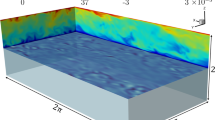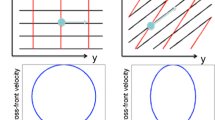Abstract
Using the exact Hasselmann equation, we study wind-driven deep-water ocean waves in a strait with the wind directed orthogonally to the shore. The strait has “dissipative” shores with no reflection from the shorelines. We show that the evolution of wave turbulence can be divided into two different regimes in time. During the first regime, waves propagate with the wind, and the wind-driven sea can be described by self-similar solutions of the Hasselmann equation. The second regime starts after a sufficiently significant accumulation of wave energy at the downwind boundary. From this instant, an ensemble of waves propagating against the wind starts to form. Moreover, waves orthogonal to the wind arise and propagate along the strait. The wave system eventually reaches an asymptotic stationary state in which two types of wave motion coexist: an ensemble of self-similar waves propagating with the wind and quasimonochromatic waves propagating almost orthogonally to the wind direction and tending to slant against the wind at the angle of 15° with respect to the shore of turbulence origination. These “secondary waves” arise only as a result of an intensive nonlinear wave interaction. The total wave energy exceeds its expected value approximately by a factor of two compared with the energy calculated in the absence of shores. We expect that this amplification increases substantially in the presence of reflective shores. We propose calling this “secondary” laser-like mechanism “nonlinear ocean wave amplification” (abbreviated NOWA).
Similar content being viewed by others
References
K. Hasselmann, “On the non-linear energy transfer in a gravity-wave spectrum: Part 1. General theory,” J. Fluid Mech.12, 481–500 (1962)
K. Hasselmann, “On the non-linear energy transfer in a gravity wave spectrum: Part 2. Conservation theorems; wave-particle analogy; irrevesibility,” J. Fluid Mech.15, 273–281 (1963).
S. I. Badulin, A. N. Pushkarev, D. T. Resio, and V. E. Zakharov, “Self-similarity of wind-driven seas,” Nonlin. Processes Geophys.12, 891–945 (2005).
A. Pushkarev and V. Zakharov, “Limited fetch revisited: Comparison of wind input terms, in surface wave modeling,” Ocean Model.103, 18–37 (2016).
V. E. Zakharov, D. Resio, and A. Pushkarev, “New wind input term consistent with experimental, theoretical, and numerical considerations,” arXiv:1212.1069v1 [physics.ao-ph] (2012).
V. Zakharov, D. Resio, and A. Pushkarev, “Balanced source terms for wave generation within the Hasselmann equation,” Nonlin. Processes Geophys.24, 581–597 (2017).
C. E. Long and D. T. Resio, “Wind wave spectral observations in Currituck Sound, North Carolina,” J. Geophys. Res.112, C05001 (2007).
S. I. Badulin, A. V. Babanin, V. E. Zakharov, and D. T. Resio, “Weakly turbulent laws of wind-wave growth,” J. Fluid Mech.591, 339–378 (2007).
A. Pushkarev, “Nonlinear generation of surface waves against the wind in a limited fetch growth model,” J. Phys.: Conf. Ser.510, 012048 (2014).
V. E. Zakharov and A. N. Pushkarev, “Classical and non-classical regimes of the limited-fetch wave growth and localized structures on the surface of water,” Ofc. Naval Res. Grant No. 00014-10-1-0991 report: https://pdfs.semanticscholar.org/d807/9d94d6df29d1e74882a0e2c2593b2d196fbb.pdf (2013).
A. N. Pushkarev and V. E. Zakharov, “Nonlinear generation of surface waves against the wind in a limited fetch growth model,” in: Proc. of 20th Meeting WISE (College Park, Maryland, USA, 21–25 April 2013), ECMWF, Maryland, USA (2013).
R. P. Fedorenko, An Introduction to Computational Physics [in Russian], MIPT Publ., Moscow (1994).
N. N. Kalitkin, Numerical Methods [in Russian], Nauka, Moscow (1978).
D. J. Webb, “Non-linear transfers between sea waves,” Deep-Sea Res.25, 279–298 (1978).
B. A. Tracy and D. T. Resio, Theory and Calculation of the Nonlinear Energy Transfer Between Sea Waves in Deep Water, U. S. Army Engineer Waterways Experiment Station, Vicksburg, Miss. (1982).
Author information
Authors and Affiliations
Corresponding author
Ethics declarations
The authors declare no conflicts of interest.
Additional information
This research was supported by a grant from the Russian Science Foundation (Project No. 19-72-30028).
Prepared from an English manuscript submitted by the authors; for the Russian version, see Teoreticheskaya i Matematicheskaya Fizika, Vol. 203, No. 1, pp. 119–133, April, 2020.
Rights and permissions
About this article
Cite this article
Pushkarev, A.N., Zakharov, V.E. Nonlinear amplification of ocean waves in straits. Theor Math Phys 203, 535–546 (2020). https://doi.org/10.1134/S0040577920040091
Received:
Revised:
Accepted:
Published:
Issue Date:
DOI: https://doi.org/10.1134/S0040577920040091




